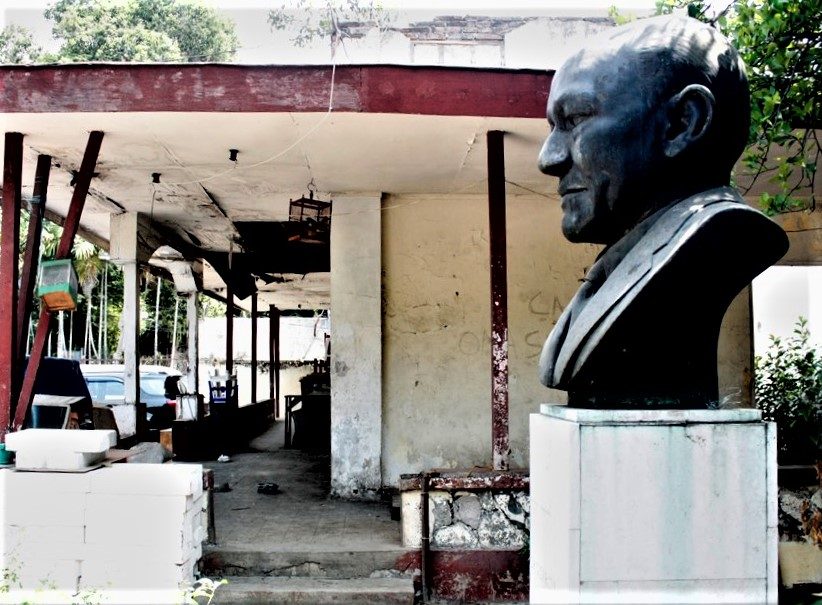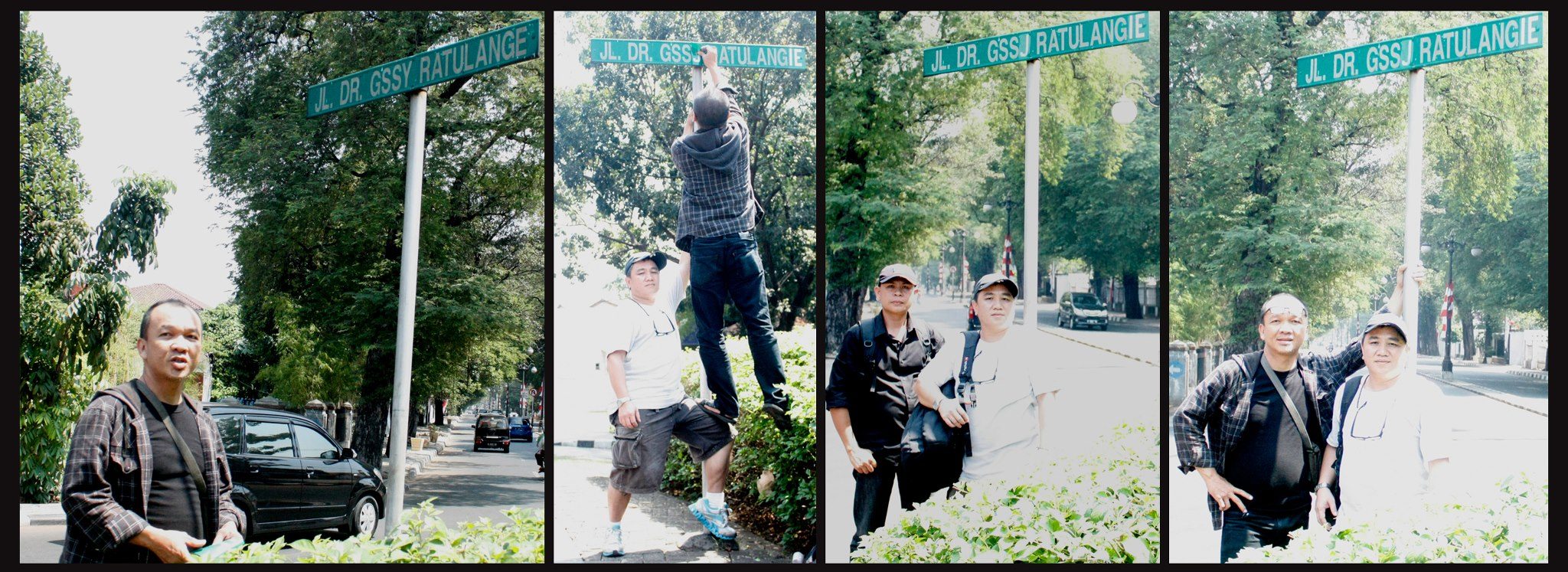
20 Agustus 2012
Oleh: Daniel Kaligis
“Bung Daniel, biar ley so tinggal di luar negeri, tapi sebagai almamater Perguruan KRIS, tetap tinggal bersama di hati. Kalau saja satu saat ada kesempatan untuk ikut sumbangsih membantu ‘memugar’ sekolah KRIS pasti akan saya lakukan.” — Rondonuwu Indra — Sydney, Australia
The son of Jozias Ratulangi and Augustina Gerungan, both from wealthy, well-respected Minahasa families, Sam Ratulangi was born in Tondano, North Sulawesi, at the time a part of the Dutch East Indies. He was a gifted student, who after completing his studies in Tondano and Batavia went to Amsterdam in the Netherlands for further studies. He graduated from a teacher’s college as a science teacher in 1915, studied for two more years at the University of Amsterdam, and in 1919 earned his Ph.D. at the University of Zurich, Switzerland.
Bermula dan Tersentak
Foto di lokasi 19 Agustus 2012

JALAN Ratulangie, Jakarta sepi, Agustus 2012. Siapa memerhati identitas jalan ini. Bertiga, para tou dari Wanua, ziarah diskusi dan berfoto di sana. Nama jalan ini telah tercetak dan terpampang: GSSY RATULANGE. Siapa peduli, sekian lama seperti itu, bertahun-tahun, hingga kami menggantinya sendiri.
Tanya ini mungkin tak untuk dijawab sekarang: “Why is our identity so important to us?” Renungkan, dan jawab di lain saat.
Diskusi dunia maya tentang sebuah gambar. Jepsony Sumual menyebut gambar itu sebagai “Rumah kediaman Dr.GSSJ Ratulangie tempo doeloe, sekaligus dijadikan sekolahan KRIS, — saat ini kelihatan tidak terawat dengan baik,” dan seterusnya.
Berikutnya, ada sejumlah tanggapan sehubungan dengan gambar yang dimaksud.
Interupsi Denny Ramagiwa
August 16 at 5:25pm
“Sebenarnya rumah ini bukan berada di Jl. Sam Ratulangie, tapi berada di Jl. Sam Ratulange. Perhatikan, bila melewati jalan ini dari arah bawah Fly Over kereta api, di tengah jalur nampak tiang nama jalan bertuliskan bukan Ratulangie tapi Ratulange tanpa huruf ‘i’.”
“Jadi jangankan merenovasi bangunan, memperbaiki nama jalan saja tidak diperhatikan,” urai Denny prihatin.
Saya coba menanggapinya, bagaimana jika nama jalan DR. GSSJ. Ratulangie yang berada di jantung ibukota negara itu kita perbaiki. Kebetulan saya ada waktu untuk datang ke Jakarta, Minggu, 19 Agustus 2012. Kami bertiga, — Denny, Jepsony, dan saya—, sepakat untuk bergerak di hari itu!

Huruf-huruf dikerjakan di Teras Thamrin City dan bangunan bersejarah kediaman DR GSSJ Ratulangie, Gondangdia, persiapan bahan stiker untuk melengkapi nama jalan.
Proses melengkapi nama jalan. posisi plang nama terlalu tinggi sehingga lutut DK menjadi pijakan untuk DR dapat mencapai, melengkapi, mengganti tulisan pada plang nama tsb. Sementara itu Jepsony Sumual mendokumentasikan kegiatan ini. Plang nama jalan ini terletak di bundaran dekat Fly Over Kereta Api Gondangdia Cikini Jakarta Pusat menuju perempatan Sabang Jakarta Pusat.

DR GERUNGAN SAUL SAMUEL JOZIAS RATULANGIE
Sumber: wikipedia
Dr. Gerungan Saul Samuel Jozias Ratulangi or Ratu Langie (November 5, 1890 – June 30, 1949), usually known as Sam Ratulangi, was a Minahasa politician, journalist and teacher from North Sulawesi, Indonesia. His famous saying in the Tondano language ‘Si Tou Timou Tumou Tou’ is translated as ‘men lives to help others live’.
The son of Jozias Ratulangi and Augustina Gerungan, both from wealthy, well-respected Minahasa families, Sam Ratulangi was born in Tondano, North Sulawesi, at the time a part of the Dutch East Indies. He was a gifted student, who after completing his studies in Tondano and Batavia went to Amsterdam in the Netherlands for further studies. He graduated from a teacher’s college as a science teacher in 1915, studied for two more years at the University of Amsterdam, and in 1919 earned his Ph.D. at the University of Zurich, Switzerland.
On his return to Indonesia, he moved to Yogyakarta to teach science at a high school, and then moved on to Bandung to found the insurance company Assurantie Maatschappij Indonesia — the first known instance of the word “Indonesia” being used in an official document. He had already led some Indonesian students’ associations in Europe, and in 1924 was appointed as secretary of the Council of Minahasan Students. He used this position to lobby for more rights and is widely credited with getting the Dutch to abolish forced labor (Herendiensten) in Minahasa.
Appointed to the Volksraad (the Dutch East Indies’ parliament) in 1927, he continued to agitate for equal rights and was one of the founding members of the United Scholars of Indonesia (Vereniging van Indonesische Academici) in 1932. He continued to serve in the Volksraad until 1937, when he was arrested and jailed for several months due to his increasing political involvement. He then became the editor of Nationale Commentaren, a Dutch-language news and issues magazine.
In June 1937 his book Indonesia in den Pacific was published, a visionary book, in which Sam Ratulangie warned against the militarisation of Japan and the possibility that Japan might invade the Indonesian archipel because of its natural resources which Japan lacks. And he described the leading role Indonesia and other countries in South-East Asia around the Pacific Rim could play – the Pacific Ocean could equal the Atlantic in importance.
In early August 1945, he was appointed as one of the members of the Preparatory Committee for Indonesian Independence, and after Sukarno’s unilateral declaration of independence on August 17, he was thereafter appointed as the governor of Celebes (Sulawesi) on August 22. Arrested by the Dutch on April 5, 1946, he was exiled for three years to Serui on Yapen Island, Western New Guinea. Freed briefly on March 23, 1948 and brought to Yogyakarta, he was captured again on December 25, 1948 when the Dutch occupied Yogyakarta. Due to his failing health, he was released again in Jakarta in February 1949, where he died on June 30.
In August 1961, Ratulangi was posthumously awarded the title of Pahlawan Kemerdekaan Nasional (National Independence Hero) by Sukarno. Manado’s Sam Ratulangi Airport, the main thoroughfare Jalan Sam Ratulangi and the Sam Ratulangi University are all named after him.
Tanya berikutnya, apa?
Ada begitu banyak pertanyaan sehubungan dengan identitas dalam kaitannya dengan eksistensi diri, bangsa, budaya, cita-cita hari ini dan masa mendatang. Semoga pertanyaan itu menjadi evaluasi sejarah yang — mungkin saja — tidak pernah terulang di lain ketika. (*)